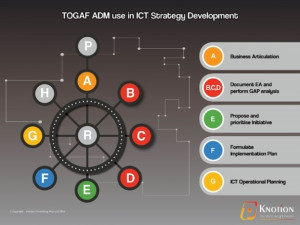Johannesburg, 31 Jan 2017
IT innovations have been changing the way in which business is done, and the pace has become even more radical. Every business that has a dependency on IT for day-to-day operations is affected by these innovations, aka, disruptive technologies, thus requiring a solid IT strategy. This IT strategy should align the business with the radical changes of the IT world through the use of enterprise architecture (EA).
EA defines the structure by which a business and its IT capabilities are organised to deliver on the business' strategic objectives. The use of new and innovative technologies introduced by an IT strategy help an organisation to have competitive advantage.
Organisations with an EA practice have the benefit of easily identifying and understanding the required changes, while also estimating their impact. An EA capability identifies which new technologies can be introduced to create cost-effective and innovative advantages for an organisation.
In a nutshell, EA ensures the business does the right things right by providing a holistic view of the business and IT, and how they work together to deliver value to the business' stakeholders.
It is therefore clear that basing your IT strategy on EA gives you the following benefits:
1. Better alignment between business objectives and IT initiatives;
2. More efficient business and IT operations;
3. Controlled IT spend with reduced risk; and
4. Increased return on investment.
The information and knowledge that can be harvested within the business, from business documentation and stakeholder engagements, is vital in the process of developing an IT strategy. This is a known business asset that can channel the responses required to address business challenges and take it to a desired future state.
Knotion Consulting has developed a unique enterprise architecture approach named smart@EA. This approach is a customised version of TOGAF and works as a plug-in to other architecture frameworks and/or IT strategy development approaches.
The articulation of the business strategy, architecture gaps consolidation, and prioritisation of the IT initiatives for implementation enable smart@EA to deliver a radical IT strategy. At the heart of smart@EA is still the TOGAF EA framework from the Open Group, and especially the architecture development method (ADM) as can be seen in Figure 1 below.

The TOGAF ADM has defined certain phases to help understand the business, its assets and capabilities, and facilitates the development of architectural assets throughout the cycle. These architectural assets are key contributions to the IT strategy that emanates out of phase F. TOGAF can be said to provide the "what" and smart@EA provides the "how to".
Smart@EA as an EA approach ensures a strong alignment between key components of an IT strategy and an IT operational plan. Hence, the adaptation of smart@EA has been successful in Knotion's engagements for the establishment of EA practices and delivery of IT strategies.
If you are wondering how smart@EA can assist you in delivering a radical IT strategy or in establishing an EA practice, then call us today for a free consultation.
Busisiwe Juleka, Senior Consultant at Knotion Consulting
Share